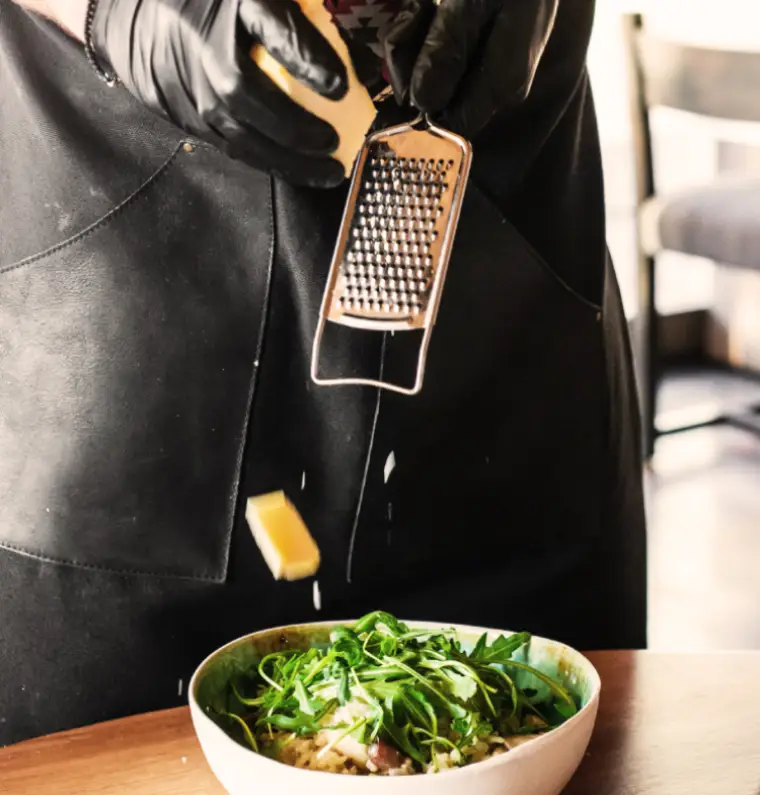
Cheif Name Surname
95%
1450

“Simplicity is the ultimate sophistication.”
Always fresh

Build WordPress sites with MaxiBlocks. All features free forever. No locked functionality. Optional Cloud Library saves you 10+ hours per project. Start free

Cheif Name Surname
95%
1450

Always fresh
Are you ready to take your WordPress website design to the next level? Our Layout Analysis tool provides a comprehensive breakdown of how to create stunning, engaging content. This guide will help you navigate through the art of creating effective layouts.
This eye-catching layout features a balanced two-column design that captivates viewers with its impactful visuals and succinct text. On the left, a striking image of a person grating food draws attention, layered with a bold quote that enhances its significance. The right column, more compact, is designed for interaction, showcasing statistics and inviting users to engage with a prominent button labeled “Read our reviews”.
Categories help you group related posts together and make finding content easier for your users. Think of categories like sections in your site’s library-they give a broad organisation method. When used effectively, they can improve site navigation and enhance your WordPress website SEO.
Tags are more specific than categories and allow you to assign keywords to your posts. They help users navigate related content easily. For example, if your site is about cooking, you might use tags like “pasta” or “gluten-free” to organise recipes beyond their general category.
Creating thoughtful menus at the top of your site gives users easy access to key sections. Submenus allow you to offer more detailed and organised navigation without overwhelming your primary menu. Discover more about submenu management in this guide.
Enhance your sidebar or footer areas with widgets. These small blocks display specific content-like search boxes, recent posts, or social media links-that enhances both functionality and user engagement.
Unlike posts, pages are static and ideal for content that doesn’t change often, like your About or Contact pages. Organise them in a way that’s logical and easy to navigate to improve accessibility for your visitors.
Post formats offer a way to style your blog posts differently based on their content. For example, a “Gallery” post format might display images differently than a “Quote” format, adding visual variety to your blog.
Custom post types allow you to categorise different content types beyond standard posts and pages. They could be anything-from products to testimonials-and give you greater flexibility in content management.
Beyond categories and tags, custom taxonomies help you further organise content elements specific to your WordPress website. They help define relationships between different types of content for better cohesion.
Make a post “sticky” to keep it at the top of your blog feed, ensuring high visibility. This feature is handy for important announcements or cornerstone content you want your audience to see.
Organise detailed information using tables, which provide a clear, structured way to present complex data. They enhance readability, especially for comparison posts or detailed lists.
Blogs are the backbone of WordPress sites, delivering news, updates, and insights to your audience. They are updated regularly and can feature a range of topics. Learn more about crafting effective blog content with this guide on WordPress menus.
Engage users by embedding videos from platforms like YouTube or Vimeo directly into your site. They are perfect for how-to guides, product demos, or vlogs, making content more engaging and informative.
Use WordPress to host podcasts, providing an alternative content format for your audience who prefers audio content. Promote dialogues, interviews, or storytelling with ease.
Visuals like infographics can present data or complex information in an easy-to-digest way. They are ideal for sharing on social platforms, driving engagement back to your WordPress website.
Feature multiple images in a gallery format to display visually rich content. Great for portfolios, travel blogs, or product showcases, galleries can captivate users with visual storytelling.
Share personal experiences, opinions, and ratings on products. Reviews can provide valuable insights for readers and help establish your authority in a particular niche.
Create step-by-step guides or how-to posts to provide valuable information to your audience. Tutorials are instructional and often use a mix of text, images, and videos to ensure clarity and engagement.
Present real-world examples and outcomes using your products or services through case studies. They help build credibility and showcase the tangible benefits of what you offer.
Create a dedicated section for newsletters that keeps your audience informed on the latest happenings, updates, and exclusive content direct from your WordPress website.
Share anecdotes or personal narratives to connect with your audience on a more emotional level. Stories help humanise your brand and foster a sense of community.
Elevating your WordPress website design is about more than just choosing a free WordPress theme. By leveraging layout analysis and embracing dynamic design strategies, you can craft a user experience that’s both visually appealing and highly functional. Dive into the world of minimalist design, and utilise engaging, interactive elements to watch your website transform. Explore the abundance of tools, such as the WordPress templates and Gutenberg blocks to further enhance your site today!
